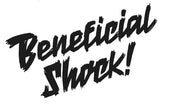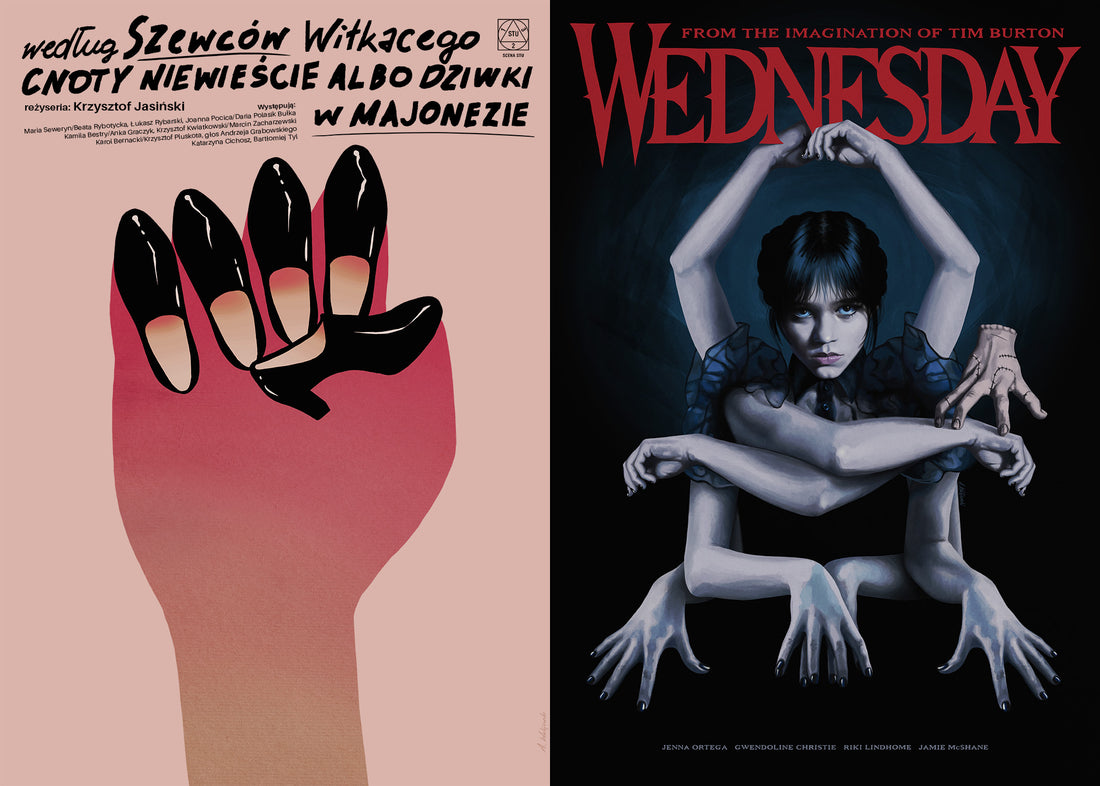With a distinctively evocative approach, Aleksander Walijewski has steadily built up a dynamic portfolio of work for an enviable roster of clients who hire him for an ability to convey both a conceptual maturity and playful ambiguity. We spoke to Aleksander from his home in Poland about early influences, the endless opportunities a portrait provides and how censorship can often result in the most memorable outcomes.
Thanks for taking the time to share your working process with us Aleksander. So, when did your love of film and love of art begin to converge?
I remember the moment exactly. It was 2016 and I was a graphic design student. I received a phone call from a movie director who contacted me about the Eminem sculpture I made. He asked me for permission to use the sculpture as a prop on the film set. One thing led to another and I designed the poster for his film. It was the first poster I ever designed and I just fell in love with this form of art. A few months later I had to start working on my undergraduate diploma work and I decided to design a series of posters for classic horror films. At that point I was hooked on designing film posters.

What were some of the things you learned under the guidance of Grzegorz Marszałek while studying in Poznań, as he is known as a master of the craft from Poland's golden age of poster design?
Right after I decided that I wanted to continue my adventure with poster art, I moved to Poznań to study at the University of Arts and attend the Poster Studio led by Professor Marszałek - and I'm glad I did. I learned a lot about condensing an idea into simple form, about playing with metaphors and symbols and most of all to have fun with the whole process of creating a poster. I started my first classes with a lack of self-confidence, not believing in my own abilities, but once I graduated and defended my diploma in the Professor's Studio, I gained more faith in what I do.
I've always found many celebrated East European film posters to be quite unsettling. I appreciate there was often a subversive political undercurrent to the posters, but I'm not sure if this accounted for what I was picking up on. Can you elaborate a bit on what your understanding is of the particular qualities shared by those iconic posters by the likes of Roman Cieslewicz, Jan Lenica and Andrzej Pagowski? Was it simply a stylistic approach to draw people in through strange or surreal images?
I guess you can say that surreal times call for surreal art. In this case the visual language that these artists used was definitely driven by the political situation. They knew exactly how to hide subliminal messages in their film posters. This type of visual language in poster art began to develop quite strongly in Poland after regaining independence in 1918, when the art of the streets became increasingly bold and metaphorical, sometimes full of satire and irony. Subsequent generations of graphic artists, who had a rich painting experience, continued this path of developing poster art. The poster became a game, a dialogue with the viewer. The creators consciously played with contexts and metaphors, very often making the poster ambiguous. And this ability was visible in posters that expressed opposition to the power of The Polish People's Republic, but they showed it in such a subtle way to avoid the tough censorship laws.

'I like finding surprising ways to combine images which use symbols that are well known to make the final artwork understandable, but at the same time open to interpretation. It’s a bit tricky with film posters because the artwork can’t give away too much of the story. I try to find ways to make the poster intriguing for viewers so that after watching the film they can go "It makes even more sense now!”.'
Your posters for Rosemary's Baby, Apocalypse Now and Our Father are prime examples of cleverly combining two ideas into one image, the origins of which seem to go back to the rabbit/duck illustration made famous by Ludwig Wittgenstein at the end of the 19th century. Are you often looking for ways to incorporate these psychological 'games' or 'visual riddles' into your work?
It’s usually one of my approaches during the sketching stage. I think that if it’s done right it can convey a lot of substance to the viewers and push them to analyze the meaning of it. I like finding surprising ways to combine images like that by using symbols that are well known to make the final artwork understandable, but at the same time open to interpretation. It’s a bit tricky with film posters because the artwork can’t give away too much of the story. I try to find ways to make the poster intriguing for viewers so that after watching the film they can go "It makes even more sense now!”.
From looking at your body of work, I imagine you to be inspired by surrealism and abstraction quite heavily. Is this correct and if so, what is it about these artistic approaches that interest you?
Surrealism mostly. I've always been inspired heavily by Salvador Dali, Rene Margritte and Polish poster artists such as Wiesław Wałkuski and Rafał Olbiński whose work was also heavily inspired by Surrealism. Works that are built in this way affect the imagination; they’re very stimulating, absorbing and it is hard to take your eyes off them. I love creating artworks inspired by surrealism, while remembering that the poster must maintain a certain logic in its message.
Heads are a common element in your work - distorted, reconfigured, morphed or deconstructed. Is this just your way of subverting the more mainstream use of 'floating heads' in film posters; offering up a more mature way of using human psychology as the basis of ideas?
I am interested in the artistic side of the poster, but luckily for me there is still a demand for portraits in mainstream posters, because distributors very often believe that nothing sells a film like the image of the film's actor(s). For my part, I was just always fascinated by portraying people. I started painting portraits when I was four years old so you might think I would be fed up with it by now, but it’s quite the opposite. It's amazing how many ways there are to say something with a portrait. The human face itself conveys a lot of emotions, and when you start combining it with other elements and symbols, countless permutations open up to express what you need to convey in the poster. Of course, I don't limit myself to portraits only; I always want to go outside my comfort zone to offer my clients different approaches.

'The human face itself conveys a lot of emotions, and when you start combining it with other elements and symbols, countless permutations open up to express what you need to convey in the poster.'
Is there an example you can give of a poster you designed that ended up drastically different from where it began and how that process developed?
I honestly can’t think of any example. I guess I’m lucky! There were a few times where I’ve had many revisions and was adding loads of corrections but it was a matter of illustration detail and typographic changes. I think the reason for the lack of drastic changes between sketch and final poster is that after the sketching stage we have the concept and composition set. Also, the clients who are familiar with my portfolio know what to expect when it comes to the aesthetics of the final artwork.
Are you in charge of the typography for all of your posters? If yes, what are your guiding principles when merging type and image?
Almost always, yes. There have only been a few exceptions due to guidelines of bigger distributors. While designing a poster you have to think of the whole composition, and typography is an important part of that, so this is why I always want to be in charge of it.
I like to have fun with that element of the poster because even the billing block (which includes the names of actors, producers, logos, etc.) can be treated creatively. For example, on the poster for Buster’s Mal Heart (dir. by Sarah Adina Smith) instead of writing the credits in a block of text, I composed the names of actors and creators as if they’re descriptions of the heart's anatomy. It completed the illustration. There isn't always a place for solutions like that but it’s definitely worth experimenting and breaking some rules.

Are there any compromises you feel you still need to make when creating posters for film or theatre, and if so what are they?
My clients give me a lot of creative freedom so I shouldn’t complain. There are of course compromises on the process through a project. For example, sometimes I’m not happy with the choice made by the client of the concept sketch but at the end I have to respect their opinion and do my best to realize the artwork so we will both be happy with it.

You are continuing in a long line of conceptually driven and independently minded East European poster artists, so who else do you think is doing interesting and inspirational work at the moment?
I love the poster concepts by Michał Krasnopolski, especially his posters for Interstellar and Good Morning Vietnam. The posters by Grzegorz Domaradzki and Krzysztof Domaradzki blow me away with their incredibly detailed style. It’s also always a motivational kick when Akiko Stehrenberger publishes a new poster.
(*see our interview with Akiko for lots of her poster images)
Are there examples of what you believe to be a perfect film poster? Or if not - what are a few of your favorites (and why?)
I was recently impressed by Javier Jaén's poster for Parallel Mothers. It refers to the film in an artistic, original way, but above all, it brilliantly fulfilled its role in promoting the film. This is a poster that is impossible not to notice on the street or in the cinema and I don't believe that someone could scroll through on social media without stopping for a second once they see it. At one point, this poster was even banned on instagram so as you can see, in a way censorship is an issue that artists still need to be aware of. I love that this poster teeters on the border of what is considered acceptable for our eyes in a public space or on social media.
And lastly Aleksander, are there particular filmmakers you would like to do work for - directors that your philosophy of working would fit well?
You have to dream big, so I would love the opportunity to design a poster for a Christopher Nolan film. He deals with high concept ideas so I feel like it could be a perfect challenge for me and I could come up with some interesting designs for his films. It would also be incredible to do work for David Fincher and Quentin Tarantino.
See more of Aleksander's work at walijewski.com

